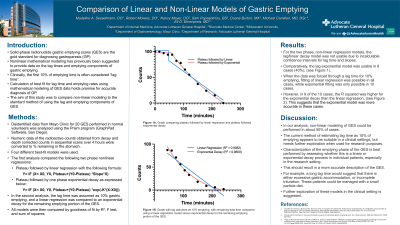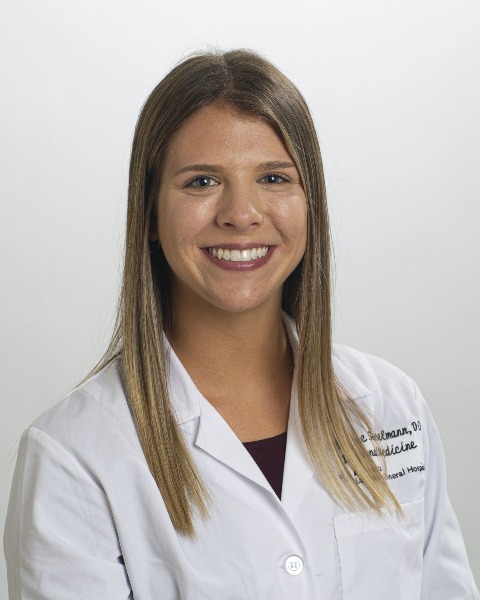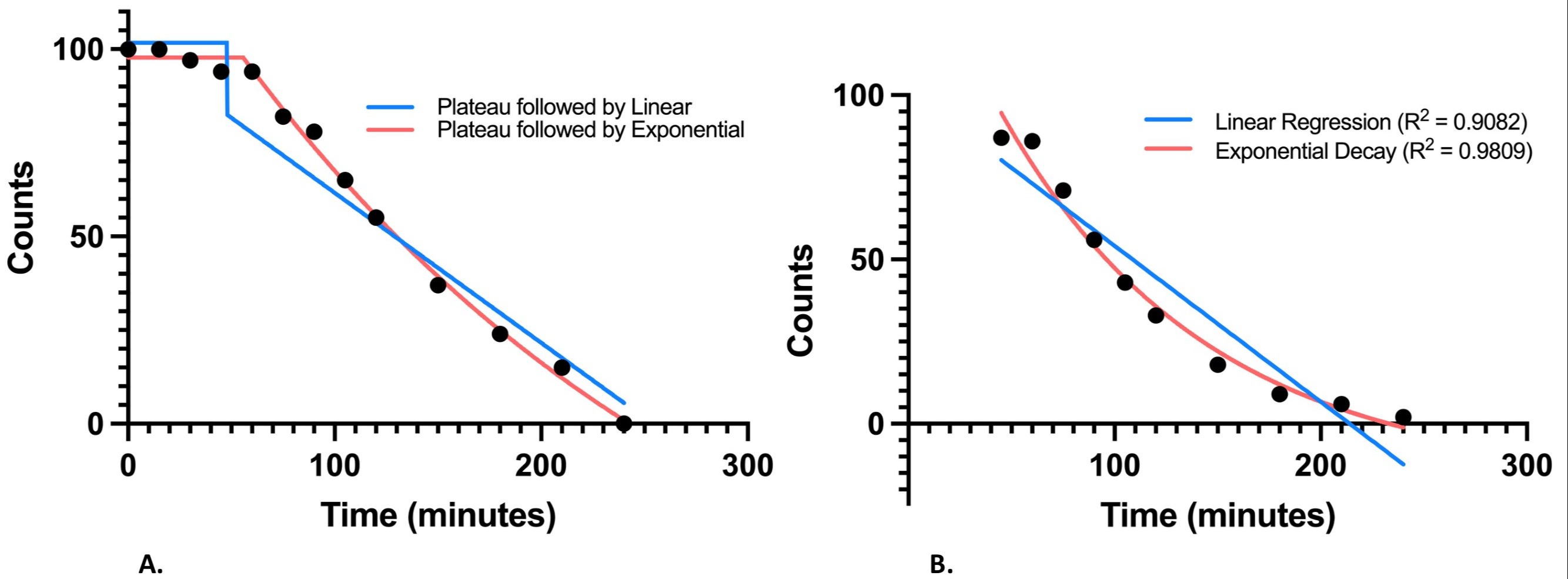Monday Poster Session
Category: Stomach
P2727 - Comparison of Linear and Non-Linear Models of Gastric Emptying
Monday, October 23, 2023
10:30 AM - 4:15 PM PT
Location: Exhibit Hall

Has Audio

Madeline Sesselmann, DO
Advocate Aurora Health
Chicago, IL
Presenting Author(s)
Madeline Sesselmann, DO1, Robert Mowery, DO2, Nancy Mayer, DO3, Sam Papasotiriou, BS4, Duane D. Burton, MA5, Michael Camilleri, MD, DSc5, Eli D. Ehrenpreis, MD6
1Advocate Aurora Health, Chicago, IL; 2Advocate Lutheran General Hospital, Chicago, IL; 3Riverside Medical Center, Chicago, IL; 4Advocate Lutheran General, Chicago, IL; 5Mayo Clinic, Rochester, MN; 6Advocate Lutheran General Hospital, Skokie, IL
Introduction: Solid-phase radionuclide gastric emptying scans (GES) are the gold standard for diagnosing gastroparesis (GP). Nonlinear mathematical modeling has previously been suggested to provide data on the lag times and emptying components of gastric emptying, although clinically emptying time of 10% of the meal is often considered “lag time”. Calculation of best fit for lag time and emptying rates using mathematical modeling of GES data holds promise for accurate diagnosis of GP. The aim of this study was to compare non-linear modeling to describe the lag and emptying components of GES.
Methods: Deidentified data from Mayo Clinic for 20 GES was analyzed using the Prism program (GraphPad Software, San Diego). Numeric data of the radioactive counts obtained from decay and depth corrected counts in sequential scans over 4 hours were converted to % remaining in the stomach. Four different best-fit models were used. The first analysis compared two phase nonlinear regressions, plateau followed by linear regression with the following formula:
Y= IF (X< X0, Y0, Plateau+(Y0-Plateau) *Slope*X)
and plateau followed by one phase exponential decay as expressed below:
Y= IF (X< X0, Y0, Plateau+(Y0-Plateau) *exp(-K*(X-X0)))
In the second analysis the lag time was assumed as 10% gastric emptying, and a linear regression was compared to an exponential decay for the remaining emptying portion of the GES. All models were then compared by goodness of fit by R2, F test, and sum of squares.
Results: For the two phase, non-linear regressions, the lag/linear decay model was not usable due to incalculable confidence intervals for lag time and slopes. Comparatively, the lag exponential model was usable in 8 cases (40%), (see Figure 1).
When the data was forced through a lag time for 10% emptying, fitting of linear regression was possible in all cases, while exponential fitting was only possible in 10 cases. However, in 9 of the 10 cases, the R squared was higher for the exponential decay than the linear regression, (see Figure 2).
Discussion: In our analysis, non-linear modeling of GES could be performed in about 50% of cases. The current method of estimating lag time as 10% of emptying appears to be suitable in a clinical setting. Characterization of the emptying phase of the GES is best performed by assessing whether this is a linear or exponential decay process in individual patients. This should result in a more accurate description of the GES and may be helpful in guiding future therapy for patients with GP.

Disclosures:
Madeline Sesselmann, DO1, Robert Mowery, DO2, Nancy Mayer, DO3, Sam Papasotiriou, BS4, Duane D. Burton, MA5, Michael Camilleri, MD, DSc5, Eli D. Ehrenpreis, MD6. P2727 - Comparison of Linear and Non-Linear Models of Gastric Emptying, ACG 2023 Annual Scientific Meeting Abstracts. Vancouver, BC, Canada: American College of Gastroenterology.
1Advocate Aurora Health, Chicago, IL; 2Advocate Lutheran General Hospital, Chicago, IL; 3Riverside Medical Center, Chicago, IL; 4Advocate Lutheran General, Chicago, IL; 5Mayo Clinic, Rochester, MN; 6Advocate Lutheran General Hospital, Skokie, IL
Introduction: Solid-phase radionuclide gastric emptying scans (GES) are the gold standard for diagnosing gastroparesis (GP). Nonlinear mathematical modeling has previously been suggested to provide data on the lag times and emptying components of gastric emptying, although clinically emptying time of 10% of the meal is often considered “lag time”. Calculation of best fit for lag time and emptying rates using mathematical modeling of GES data holds promise for accurate diagnosis of GP. The aim of this study was to compare non-linear modeling to describe the lag and emptying components of GES.
Methods: Deidentified data from Mayo Clinic for 20 GES was analyzed using the Prism program (GraphPad Software, San Diego). Numeric data of the radioactive counts obtained from decay and depth corrected counts in sequential scans over 4 hours were converted to % remaining in the stomach. Four different best-fit models were used. The first analysis compared two phase nonlinear regressions, plateau followed by linear regression with the following formula:
Y= IF (X< X0, Y0, Plateau+(Y0-Plateau) *Slope*X)
and plateau followed by one phase exponential decay as expressed below:
Y= IF (X< X0, Y0, Plateau+(Y0-Plateau) *exp(-K*(X-X0)))
In the second analysis the lag time was assumed as 10% gastric emptying, and a linear regression was compared to an exponential decay for the remaining emptying portion of the GES. All models were then compared by goodness of fit by R2, F test, and sum of squares.
Results: For the two phase, non-linear regressions, the lag/linear decay model was not usable due to incalculable confidence intervals for lag time and slopes. Comparatively, the lag exponential model was usable in 8 cases (40%), (see Figure 1).
When the data was forced through a lag time for 10% emptying, fitting of linear regression was possible in all cases, while exponential fitting was only possible in 10 cases. However, in 9 of the 10 cases, the R squared was higher for the exponential decay than the linear regression, (see Figure 2).
Discussion: In our analysis, non-linear modeling of GES could be performed in about 50% of cases. The current method of estimating lag time as 10% of emptying appears to be suitable in a clinical setting. Characterization of the emptying phase of the GES is best performed by assessing whether this is a linear or exponential decay process in individual patients. This should result in a more accurate description of the GES and may be helpful in guiding future therapy for patients with GP.

Figure: Figure 1A. Graph comparing plateau followed by linear regression and plateau followed exponential decay. Figure 1B. Graph with lag assumed as 10% emptying, with remaining data then compared using a linear regression model versus exponential decay for the remaining emptying portion of the GES.
Disclosures:
Madeline Sesselmann indicated no relevant financial relationships.
Robert Mowery indicated no relevant financial relationships.
Nancy Mayer indicated no relevant financial relationships.
Sam Papasotiriou indicated no relevant financial relationships.
Duane Burton indicated no relevant financial relationships.
Michael Camilleri: NGM Biopharmaceuticals – Grant/Research Support.
Eli Ehrenpreis: E2Bio Life Sciences – Intellectual Property/Patents, Owner/Ownership Interest, Stock-privately held company. G.I. Pharmaceuticals, Inc. – Intellectual Property/Patents, Owner/Ownership Interest. Level Ex – Consultant.
Madeline Sesselmann, DO1, Robert Mowery, DO2, Nancy Mayer, DO3, Sam Papasotiriou, BS4, Duane D. Burton, MA5, Michael Camilleri, MD, DSc5, Eli D. Ehrenpreis, MD6. P2727 - Comparison of Linear and Non-Linear Models of Gastric Emptying, ACG 2023 Annual Scientific Meeting Abstracts. Vancouver, BC, Canada: American College of Gastroenterology.

